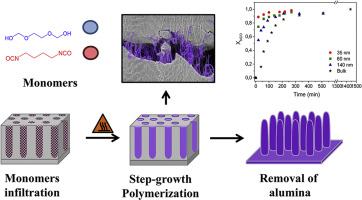Polymer ( IF 4.1 ) Pub Date : 2018-02-22 , DOI: 10.1016/j.polymer.2018.02.041 Belén Sanz , Nicholas Ballard , Ángel Marcos-Fernández , José M. Asua , Carmen Mijangos

|
Nanostructured polyurethanes have attracted substantial interest for the generation of “smart” surfaces, but step-growth polymerization at the nanoscale has scarcely been reported. In this work, the synthesis of polyurethanes by step-growth polymerization in the nanocavities of anodized aluminum oxide (AAO) templates is studied, finding that the kinetics of the reaction was faster than in bulk, while the molecular weight and the dispersity were reduced. A mathematical model was developed to explain these differences, taking into account the chemical and physical interactions encountered in the reaction between the monomers (diisocyanate and dialcohol) for nanoconfined in AAO and bulk. In nanoconfinement, the polyaddition is catalyzed by hydroxyl groups on the pore wall, resulting in an increase in the rate of polymerization during the early stages of the reaction. At high conversions, the limited diffusion of the polymer chains results in a slower polymerization and a dispersity lower than that expected from bulk.
中文翻译:

AAO模板和模型中逐步增长聚合的限制效应
纳米结构聚氨酯已经吸引了人们对于“智能”表面生成的广泛兴趣,但是几乎没有报道过纳米级的逐步增长聚合反应。在这项工作中,研究了在阳极氧化铝(AAO)模板的纳米腔中通过逐步增长聚合法合成聚氨酯,发现反应动力学比本体反应快,而分子量和分散性却降低了。考虑到在AAO和本体中的纳米级受限的单体(二异氰酸酯和二元醇)之间的反应中遇到的化学和物理相互作用,开发了一个数学模型来解释这些差异。在纳米约束中,加成是由孔壁上的羟基催化的,在反应的早期阶段导致聚合速率的增加。在高转化率下,聚合物链的有限扩散导致聚合反应较慢,且分散度低于本体预期的分散度。











































 京公网安备 11010802027423号
京公网安备 11010802027423号